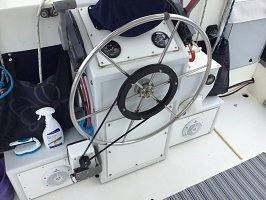I'm currently leaning towards getting a CPT Autopilot to replace the old failed AutoHelm 3000 on our 38-200. After review of the product descriptions and forum discussions, the ease of installation, overbuilt motor, relatively low noise level, and low power draw are attracting me to this device as well as the cost compared to another below deck direct drive unit or the RayMarine wheeldrive (cheaper, more bells and whistles, but weaker motor). After reviewing the various manuals, one thing that rises as a potential concern about the CPT is the clutch, which has little description, just a drawing. It appears to be a knob for engaging two pins in order to rotate the belt drive wheel and the belts and wheels are completely exposed, albeit behind the helm wheel. My concern is getting fingers caught between the belt and drive wheel in a hasty attempt to engage or disengage the clutch. Can folks with CPT autopilot experience provide some perspective on this concern? Is there a preferred motor placement that minimizes this concern?
Thanks.
Alan
Thanks.
Alan

